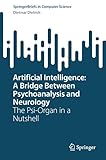Artificial Intelligence: A Bridge Between Psychoanalysis and Neurology [electronic resource] : The Psi-Organ in a Nutshell /
Material type: TextSeries: SpringerBriefs in Computer SciencePublisher: Cham : Springer Nature Switzerland : Imprint: Springer, 2023Edition: 1st ed. 2023Description: XIII, 58 p. 10 illus., 2 illus. in color. online resourceContent type:
TextSeries: SpringerBriefs in Computer SciencePublisher: Cham : Springer Nature Switzerland : Imprint: Springer, 2023Edition: 1st ed. 2023Description: XIII, 58 p. 10 illus., 2 illus. in color. online resourceContent type: - text
- computer
- online resource
- 9783031303685
- 006.3 23
- Q334-342
- TA347.A78
1. Introduction -- 2. Principles of Description -- 3. Functions and Their Behavior -- 4. Extended Mealy Theory -- 5. Information Systems of High Intelligence -- 6. World of Hardware – Neuroscience and More -- 7. World of Information – Pscychoanalysis and More -- 8. The Ψ-Organ: A SiMA Model -- 9. Turing, Intelligence and the Self -- 11. Scientific Elaboration of Consciousness.
To be able to merge the psyche with the neural system has been a long-sought goal. There is much scientific literature on results from research on this topic, but the goal of this “booklet” is to present the subject in a nutshell and to attract a wider audience to this highly complex topic. Scientists often need years to grasp the scope and implications of merging the psyche with the neural system. Does that really have to be the case? What does the simulated model look like? What are the underlying philosophies? Can it be understood without mathematical formalism? Uniting the psyche and neurology in one model, on the one hand, allows psychological and social theories to be tested on a scientific basis using simulation experiments. On the other hand, a model developed according to the functional structures of the human brain, let us call it the Psi-Organ, which comprises neurology and psyche as one unit, can serve as a basis for AI systems. These can be systems with cognitivecapabilities that save human lives, save energy, ensure safety at airports, provide support in caring for the elderly and much more. In other words, systems that can simplify our lives in the most relevant ways and on a broad basis. This model, the Psi-Organ, goes far beyond today's primarily behavior-based AI methods. The manuscript can serve as an excellent introduction to the problem of understanding and modelling the human mind, and to the problem of achieving artificial “intelligence” in general, increasing awareness and understanding for the associated challenges. In that regard, it is a valuable supplementary text for advanced students or researchers in the field, notably not only in AI, but also (and perhaps primarily) in the medical fields.


There are no comments on this title.